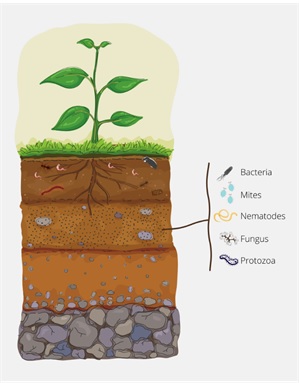On the evening that many countries anticipate a well-known bearded gentleman dressed in red (or green!) climbing down their chimneys, we should also take a moment to celebrate a substance which is often trampled underfoot, but which is in fact the foundation of the earth’s food system and is vital to our everyday survival: soil! World Soil Day[1] encourages global discussions about the importance of soil in our ecosystem and spreads awareness of issues relating to changes in the Earth’s soils which could have devastating consequences if left unchallenged. Here we will discuss why soil is so important and what can be done to protect the world’s soil reserves.

Why is soil so important?
Soil provides a habitat for more than a quarter of our planet’s diversity[2], known as the soil food web, which includes most of the world’s terrestrial primary consumers and decomposers. Without a healthy soil biome, supplying nutrients to the producers, none of the world’s forests, containing so much of the earth’s biodiversity, could exist. By supporting healthy forests and woodland, soils play an integral part in the carbon cycle, and so is crucial to maintaining a healthy atmosphere and mitigating climate change. The soil food web also protects against pests, diseases, drought, and flooding[3].
And what is the problem?
Forests support themselves through a delicate cycle of death and growth, making them the most productive ecosystems in the world. In agriculture, fields are ploughed to quickly grow fresh plants from seeds, but this process destroys the larger microorganisms in the soil, such as protozoa and fungi, disrupting the soil food web balance and breaking the delicate cycle. In order to compensate, fertilisers and pesticides are added to soil to provide the necessary environment for plants to grow without presence of the natural food web. Increased pesticide use has contributed to around a quarter of the world’s insect population being lost every decade for the last three decades[4], which has led to population loss in other animal groups higher up the food chain such as birds[5]. Disruption higher up the food chain has also encouraged many invasive species to flourish, bringing about further disruption.
The soil food web also provides structure to the top layer of soil, which protects the nutrient-rich topsoil from erosion. The FAO (United Nations’ Food and Agriculture Organisation) estimates that all of the world’s topsoil will be depleted within around 60 years if current rates are maintained[6]. Adding to this that 68% of the world population are predicted to live in urban areas by 2050[7], sealing more and more soil under an artificial canopy, the future is not looking great for this precious resource. Replenishing healthy soil food webs is essential to combat the effects of erosion and maintain healthy, fertile land, vital for sustaining ecosystems and feeding a rapidly growing population.
So, what can be done?
The good news is that, by relying on natural fertilisers and pesticides, the soil food web can be restored extremely quickly. If more natural, sustainable practices are adopted in agriculture, then it is possible to measure increases in biodiversity and topsoil structures within months. Where farmers have adapted to use more natural methods, they have seen natural pest control and fertile, nutrient rich soil returned to yield healthy crops[8]. Much of the challenge is in raising awareness and promoting the benefits of natural farming methods.
There are examples of cities with vast areas of designated green space and wild, uncultivated land are being developed and protected, creating urban spaces which promote healthy soil food webs instead of smothering them[9]. Teaching sustainable practices in schools will develop a generation of environmentally conscious farmers who are more likely to opt for sustainable farming practices. By being more environmentally conscious and promoting the three R’s (reuse, recycle, reduce), you could help (even just a bit) to develop an environmentally focused ethos which will spread through your circles and beyond and help mould a future society more in touch with the natural world.
Prospects of healthy soil in the Anthropocene
In today’s fast paced society, the imprint of human activity on soil quality can be found everywhere. We use our lands for several purposes including agricultural practices, food and feedstock production, deforestation, energy production, waste management practices, urbanisation, use of landfills… the list is endless.
All these activities if goes unchecked have detrimental and long-lasting effects on soil biodiversity and their related ecosystem services. As our decisions on how we use the land, what food we consume and how we grow it and in what ways we produce our energy all affect the quality and health of our soils.[10] In fact, the extent of human impact is now so prevalent that there is a proposed new geological epoch the ‘Anthropocene’ characterized by the significant impact humans have on Earth’s ecosystems and its geology.[11]
One major concern related to soil degradation are the currently used unsustainable land management practices including, large-scale ‘land use changes’ and ‘land grabbing’. ‘Land use change’ refers to altering the vegetation cover (for example from natural grassland to cropland) that disturbs soil and removes essential biomass.[12] Land use change related to green energy production is a major contributor to these unsustainable practices. Hence, the increase in biofuel feedstocks demand is also a main concern for soil protection.
Geonardo works on addressing these issues of direct and indirect land changes in bioenergy production through its EU funded project BIOPLAT-EU. The overall objective of the project is to promote the market uptake of sustainable bioenergy in Europe using marginal, underutilized, and contaminated lands for non-food biomass production through the provision of a web-based platform that serves as a decision support tool.
Marginal, Underutilized, and Contaminated lands (MUC) cannot be used for food production or for recreational and conservation purposes, but in some cases, they still retain the potential to produce biomass for non-food purposes. In other cases, choosing the most suitable crop can also help to remediate soil conditions on these lands.
BIOPLAT-EU works on creating a database of maps to collect data about the available MUC lands in Europe. The project also includes the development of a public user-friendly tool (STEN: Sustainability Tool for Europe and Neighbouring countries) that will assess the environmental, social and techno-economic sustainability aspects of scenarios and value chains with respect to specific economic and noneconomic conditions for bioenergy production on marginal lands. The project also has a strong focus on the mobilisation and involvement of local stakeholders in order to create the best conditions for sustainable bioenergy production.
BIOPLAT-EU helps to address the trade-offs between bioenergy production and land us change while keeping in mind aspects of soil conservation as well.
--
[1] Breyer, M. (2019). 5 Things Everyone Can Do to Protect the Planet’s Soil. https://www.treehugger.com/things-everyone-protect-soil-4855245
[2] FAO United Nations. (2018). Theme | World Soil Day | Food and Agriculture Organization of the United Nations. http://www.fao.org/world-soil-day/theme/en/
[3] The Royal Society. (2020). Soil structure and its benefits.
[4] Sánchez-Bayo, F., & Wyckhuys, K. A. G. (2019). Worldwide decline of the entomofauna: A review of its drivers. In Biological Conservation (Vol. 232, pp. 8–27). Elsevier Ltd. https://doi.org/10.1016/j.biocon.2019.01.020
[5] Hallmann, C. A. (2019). A tragedy of the common Wild bird and insect decline in the current era. https://www.ipskampprinting.nl/
[6] Stockdale, D. E., Tolhurst, I., Cronin, J., Lalor, P., Molloy, D., & Bright, C. (2015). 2015 International Year of Soils. http://www.fao.org/soils-2015/events/detail/en/c/338738/
[7] United Nations Department of Economic and Social Affairs. (2018). 68% of the world population projected to live in urban areas by 2050, says UN | UN DESA | United Nations Department of Economic and Social Affairs. https://www.un.org/development/desa/en/news/population/2018-revision-of-world-urbanization-prospects.html
[8] Krauss, M., Berner, A., Perrochet, F., Frei, R., Niggli, U., & Mäder, P. (2020). Enhanced soil quality with reduced tillage and solid manures in organic farming – a synthesis of 15 years. Scientific Reports, 10(1), 1–12. https://doi.org/10.1038/s41598-020-61320-8
[9] Heng, L. L. (1991). Wildlife Protection Laws in Singapore. Singapore Journal of Legal Studies, 1991. https://heinonline.org/HOL/Page?handle=hein.journals/sjls1991&id=299&div=&collection=
[10] R .Weil, R. and Brady, N., 2017. Prospects for Global Soil Quality as Affected by Human Activities. In: R. Weil, ed., he Nature and Properties of Soils, 15th ed. Pearson Prentice Hall, pp.pp.982-1040.
[11] Fernando José Garbuio, Jeffrey L. Howard, Larissa Macedo dos Santos, "Impact of Human Activities on Soil Contamination", Applied and Environmental Soil Science, vol. 2012, Article ID 619548, 2 pages, 2012. https://doi.org/10.1155/2012/619548
[12] FAO and ITPS. 2015. Status of the World’s Soil Resources (SWSR) – Main Report.
Food and Agriculture Organization of the United Nationsand Intergovernmental Technical Panel on Soils, Rome, Italy




